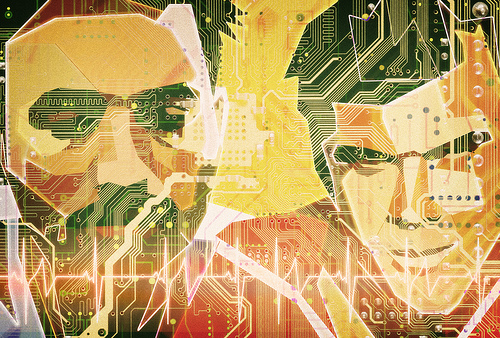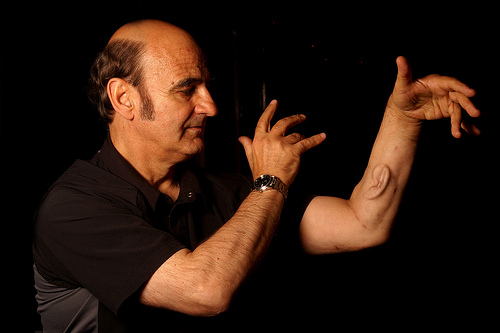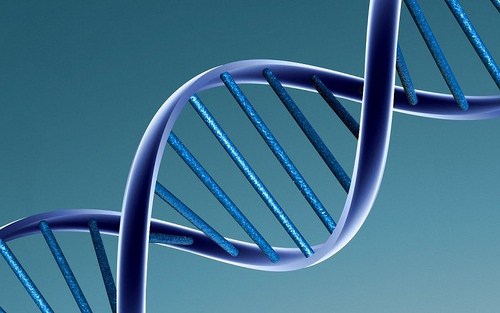32 Technology and the Body
sytaffel
A second body of literature surrounding technology and mediation relates to the ways in which technology can be understood to relate to the human body. As we saw in the previous section, one way that this relationship has been theorised is Marshall McLuhan’s argument that technology extends the human body into the environment. This approach assumes that that was an essential human body which pre-exists technological relations, which can then be extended through technological prosthesis. The three approaches to technology and the body can be understood as challenging this assumption that being human can be separated from being technological, suggesting in quite different ways that humans and technology cannot be separated, and that being human is also about being technological.
This is quite different from the type of thought which has largely dominated Western philosophical thought for hundreds of years, in which nature, culture, humans and technology are understood as being incommensurate with one another. Inspired by the findings of the science of cybernetics and related systems theories such as chaos and complexity theory, writers like Donna Haraway, and artists such as Stelarc have explored how the couplings of contemporary technologies and the body break down the barriers between nature and culture, human and technology. The links below lead to Stelarc’s online catalogue of performance art projects which visually and conceptually engage with a series of issues surrounding technology and body. The interview with Haraway presents some of the conceptual work around her notion that by the 1980s we had all become cyborgs – part human part machine – and how this alters our understandings of how technology and ethics can be approached.
Stelarc – Projects http://stelarc.org/?catID=20247
You Are Cyborg – An Interview with Donna Haraway http://www.wired.com/wired/archive/5.02/ffharaway_pr.html
Whilst Haraway and Stelarc provide ways of thinking about how technologies are incorporated into the body, there has been considerable interest recently in the emerging field of biotechnology, in which bodies are not merely augmented through technologies, but are instead modified and mediated at the design stage. Whilst you may be familiar with some of the debates surrounding the use of genetically modified food or the ethics of cloning, the two videos below demonstrate two different perspectives on contemporary usages of biotechnology. Ray Kurzweil provides an optimistic perspective on the variety of ways that biotechnology could be used to enhance various relationships, whilst Paul Root Wolpe examines some of the ethical quandaries which are raised through the possibilities which biotechnologies offers, questions which are going to become increasingly relevant as the technologies mature.
A final area surrounding technology and the body which has recently gained a lot of coverage in both academic writing and mainstream media, surrounds cognitive neuroscience and in particular the phenomena of neuroplasticity. It is now known that the human brain develops neural pathways according to the type of environment in which it exists. Humans are born with far more synaptic pathways than they will have as adults, as through a process called synaptogenesis the pathways which are not used disappear, whilst those which are used are strengthened. Whilst the traditional debate surrounding humans tended to oppose nature and nurture, we now know that human ‘nature’ is to be plastic, malleable and adaptable to the type of environment in which we find ourselves.
As the texts below from N Katherine Hayles and Nicholas Carr argue, a huge part of contemporary life is experienced through technological mediation. For example it is often thought that children today spend far more time with various forms of media than they do learning from their parents. Consequently, there have been a range of discussions considering what the implications are of this understanding that our relationships with our environment and technologies are altering the wiring of our brains. Both Hayles and Carr suggest that forms of attention are being modified through this process, and that broadly this can be characterised as a shift from sustained and deep engagement with singular texts to a shallow engagement with multiple forms of media, which Hayles terms hyper attention, and connects with the rise in cases of attention deficit disorder.
Nichols Carr – The Web Shatters Focus & Rewires Brains http://www.wired.com/magazine/2010/05/ff_nicholas_carr/
N Katherine Hayles – Deep and Hyper Attention: The Generational Divide in Cognitive Modes http://engl449_spring2010_01.commons.yale.edu/files/2009/11/hayles.pdf
Finally, this short video from the conference Paying Attention: Digital Media Cultures and Generational responsibilities highlights a range of ways that contemporary academics theorise the relationship between media technologies, neuroplasticity and economies of attention[S1] .
Paying Attention – A conference concerning the Attention Economy from DCRC on Vimeo.
Discussion
- List some ways that technologies have impacted upon your body, or the bodies of people that you know
- Consider what these changes have meant in terms of those people’s capabilities – how have their lives been changed?
- Do you agree with Donna Haraway’s aim that we are all cyborgs (part biological part technology)?
- If technology can change our bodies and shape our identities, what does this say about what it means to be human, or about human nature?



